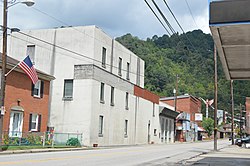Keystone, West Virginia | |
|---|---|
 U.S. Route 52 in the city's southwest | |
 Location of Keystone in McDowell County, West Virginia. | |
| Coordinates: 37°24′54″N81°26′46″W / 37.41500°N 81.44611°W | |
| Country | United States |
| State | West Virginia |
| County | McDowell |
| Government | |
| • Mayor | Dennis Robertson |
| Area | |
• Total | 0.32 sq mi (0.84 km2) |
| • Land | 0.32 sq mi (0.84 km2) |
| • Water | 0.00 sq mi (0.00 km2) |
| Elevation | 1,631 ft (497 m) |
| Population | |
• Total | 176 |
| 223 | |
| • Density | 688.27/sq mi (265.98/km2) |
| Time zone | UTC-5 (Eastern (EST)) |
| • Summer (DST) | UTC-4 (EDT) |
| ZIP code | 24852 |
| Area code | 304 |
| FIPS code | 54-43516 |
| GNIS feature ID | 1554871 [4] |
| Website | https://local.wv.gov/keystone/Pages/default.aspx |
Keystone is a city in McDowell County, West Virginia, United States. Per the 2020 census, the population was 176. [5] Keystone is one of the few municipalities in West Virginia with an African-American majority, with 65 percent of the residents being black.
Contents
- History
- Geography
- Demographics
- 2020 census
- 2010 census
- 2000 census
- Notable people
- See also
- References
- External links
The term "Free State of McDowell" was coined by Matthew Thomas Whittico, a local newspaper editor and community leader from Keystone in the early 20th century. [6] Keystone possessed a unique combination of political, social, and economic characteristics that made it an attractive place for African-Americans to migrate to in the late 1800s and early 1900s. [6]

